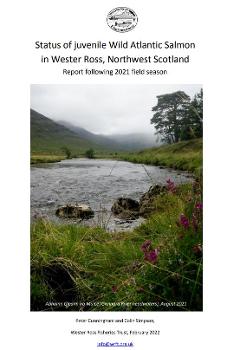Important wild salmon populations in Wester Ross need additional protection
Posted: Tuesday 1 February, 2022 @ 12:34:35

The Status of juvenile Wild Atlantic Salmon in Wester Ross report for 2021 provides a summary of the results of a survey of juvenile salmon in the Wester Ross area in July – September 2021. Over 80 sites were surveyed in 15 rivers using specially designed electro-fishing equipment. Sites were fished under contract for the Scottish Government’s National Electro-fishing Programme of Scotland [NEPS], for hydropower scheme monitoring contracts or supported by the Wester Ross Area Salmon Fishery Board [WRASFB]. Data from the SEPA fish survey team for two sites in the Gruinard River was kindly provided. Together with information from a study of genetic introgression of wild salmon populations associated with spawning of escaped farm salmon in the wild (Gilby et al 2021), some conclusions can be reached regarding the likely status of wild salmon populations within many of the rivers of the area. The report can be found via links under tabs on this website or here :
Wester Ross retains relatively strong wild juvenile salmon populations in the major rivers flowing into the Wester Ross Marine Protected Area including the rivers Kanaird (Canaird), Ullapool, Broom, Gruinard, Little Gruinard and Ewe. The rivers Kerry and Badachro also retain strong juvenile salmon populations in terms of juvenile fish densities. In contrast, the status of wild juvenile salmon populations in the rivers to the south of Loch Gairloch (rivers Torridon, Applecross) is fragile, or uncertain due to artificial stocking (River Carron). The River Balgy was not surveyed in 2021.
Our results generally, but not entirely, concur with the Scottish Government’s proposed conservation gradings (based on reported rod catches) of salmon rivers for 2022 (see: Summary information on preceding page). They support the contention that wild salmon populations in the south of the area associated with post-smolt migration routes that pass through sea areas exposed to high cumulative emissions of larval sea lice from large, circular open mesh cage salmon farms in the east of Skye and Loch Torridon are at greatest threat of being damaged further or lost in terms of any river-specific genetic adaptations.
The production of wild salmon smolts from some rivers could be higher with greater attention to the protection and restoration of riparian habitat (e.g. alder and other riverside trees), catchment area vegetation (e.g. peatlands) and food availability (e.g. addressing phosphorus deficits at whole catchment scale).
Following several riparian woodland projects around the Wester Ross area in earlier years, since 2020, local landowners have undertaken remedial actions to restore or enhance riparian woodlands along parts of the River Kanaird system, in the River Ewe headwaters, and in the Rhidorroch River (Ullapool River) headwaters where further work is planned for 2022.
Riparian habitat along the Abhainn Gleann na Muice (Gruinard River headwaters) is in urgent need of protection and recovery. The upper Bruachaig River (River Ewe headwaters) represents the largest area of freshwater habitat within the Wester Ross area where juvenile salmon production could be much higher than it has been in recent years. Other rivers where actions are needed to benefit wild salmon include parts of the rivers Kanaird, Little Gruinard, Torridon and Applecross.
Thank you to all funders and many helpers and estates for their support in 2021.